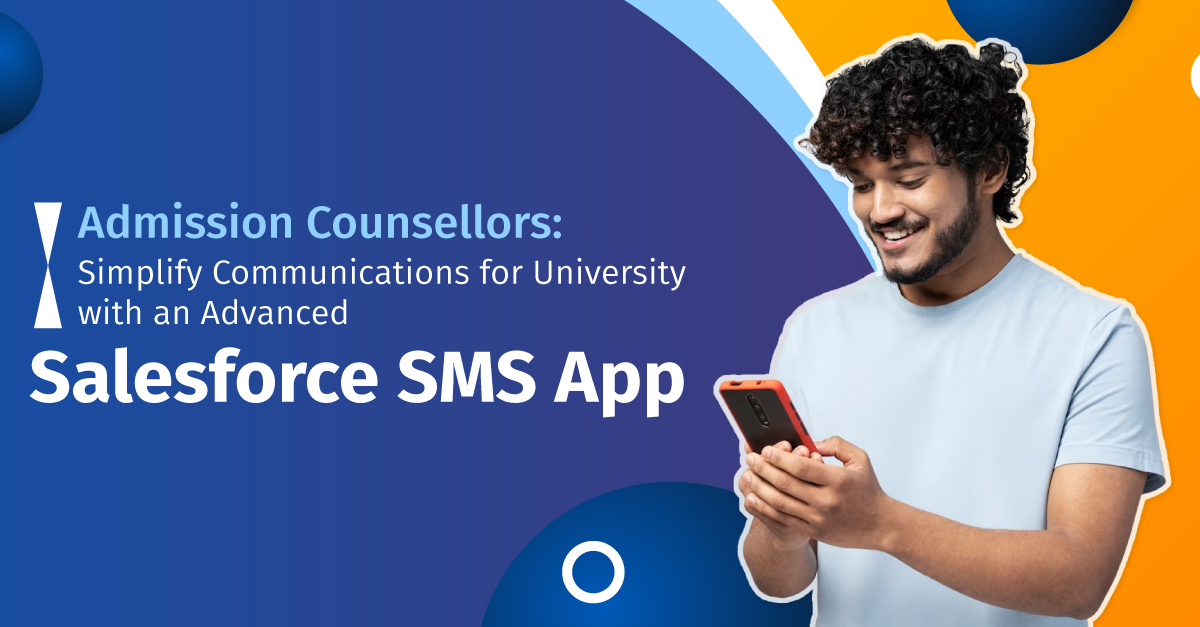 Admission Counsellors: Simplify Communications for the University with an advanced Salesforce SMS app
Admission Counsellors: Simplify Communications for the University with an advanced Salesforce SMS app
“Does texting really make a significant difference in educational communications?”
This is a million-dollar question for Salesforce users who haven’t used texting for University communications yet. But the ones who have already incorporated SMS as a communication tool to interact with students have dramatically changed their educational operations.
When relying on calls, emails, or the physical presence of students to communicate and convey crucial information, there is a fair chance that intended information does not reach students on time. Sometimes, students are unavailable to take calls or pay a visit to University, which creates communication gaps as it becomes difficult to communicate with them.
In the case of emails, too, you should expect delayed responses, as emails are not frequently checked as texts.
And the accessibility of information on time is even more crucial when information is time sensitive and you want to drive an action within a specific time frame.
Hence, you need a reliable solution to communicate in real time, ensuring that information will be viewed in no time.
That’s where Salesforce texting will hit the spot.
So if you haven’t thought of text messaging that way for educational operations, here is a lot more that you need to discover. For admission, a well-defined Salesforce texting app can be your best bet, as it has a huge potential to simplify and accelerate communications with students.
According to Pew Research, 58% of teens with smartphones cite texting as the primary way they communicate online or on their phones.
Simplifying Educational Operations with Salesforce Text Marketing for Higher Education
When your focus is on increasing admissions, the first approach would be to intrigue prospective students and engage with them. And text can help you do that in several ways.
Communicate Events, Webinars, and Open House for Increased Enrollments
Consider this:
Just put yourself in your prospective student’s shoes and think about your approach when planning to take admissions. You’d probably consider those universities first that are known to you.
During admission season, it’s high time when you have to showcase your university, educational institution, and programs more concretely to prospective students. This would help you to intrigue them and engage them.
Campus tours, information sessions, open houses, guest lectures, webinars, and events are some of the most effective ways to promote any institution or program. For the success of all such events, the participation of prospective students is essential, which you can increase with the help of texting.
Using text marketing in Salesforce for University admissions, you can promote upcoming webinars, events, open houses, etc., to prospective students, helping them learn more about your institution and programs.
Same you can do with Salesforce text marketing for school communications.
Share Success Stories for Easy Trust-building
It’s a human tendency that when you see your peers successful, it creates an impact.
It influences you, and you want to be like them, following what they have followed.
Sometimes, it’s challenging to convince prospective students when they have several other institutions to explore.
They need reasons to choose your institution over others. And you can give them this by sharing success stories from current students or alumni using Salesforce text marketing for higher education.
You can show them the impact the institution and its programs have had on the lives of others.
Using MMS, you can share short videos or redirect your prospective students to a specific page or videos by sending the URL in a text message. Further, with URL tracking, you can gauge student’s interest. You can be more innovative with Salesforce text marketing for higher education.
This way, trust-building and convincing prospective students to enroll will be easy.
Engage with Prospective Students through Informational Videos and Webinars
No stone should be left unturned to generate prospective students’ interest in your institution.
The more impressed students are by the institution, achievements, faculty, and its success, the more applications you drive.
To create a good impression, short videos can be created to showcase campus life, highlight student achievements, and promote specific programs. These videos can be shared and promoted on social media, the institution’s website, and through texts.
Further, Live or recorded webinars can be used to provide in-depth information about programs, answer questions, and encourage prospective students to apply.
Send Program and Newly Launched Course Updates
During admissions, every trivial piece of information matters to prospective students and helps them in their admission decision.
If there are any program changes, such as new course offerings or expanded program features, these updates must be sent to prospective students to keep them informed and interested.
These updates must reach prospective students on time. This can help them with admission decision-making related to a specific course or program.
For example,
Your prospective students should know if your institution has newly launched a course or program. Updating prospective students can help increase enrollments and admissions.
Remind Students of Essential Deadlines and Share Application-Related Updates
The admission process isn’t limited to a single step. It involves several steps, from application submission to fee payment, without which admissions cannot be completed.
It is essential to ensure that students follow through on their commitments to complete the admission process successfully.
And to do so, you can send automated text reminders to prospective students. You can communicate about important deadlines, such as when to submit their applications, take standardized tests, the last fee submission date, etc.
Everything should happen on time, which you can ensure by sending reminders.
According to a texting research study by Lindsay Page and Ben Castleman on Summer Melt: 84% of respondents found text reminders useful in getting everything done for college.
In addition, you can keep prospective students posted about application status and other related updates. If required, you can also ask for the necessary documents (if pending) needed to complete the admission process using SMS for education.
This will help you streamline and accelerate the admission process and steer clear of incomplete admissions
Share Financial Aid Information with Salesforce Text Marketing for Higher Education
It isn’t surprising if you will think how sharing financial aid information can help you increase admissions.
But yes, it implicitly affects admission counts.
Prospective students look for other options to cut back on educational expenses when they find it hard to bear them.
So when you provide them with options to bear educational expenses easily, it releases the pressure of financial burden, and they are more likely to enroll.
You can count on text messages in Salesforce for student communication and share information about financial aid options, including scholarships, grants, and loan options, to help prospective students finance their education.
Be Available to Address Prospective Student’s Queries 24*7
Quality services always reflect your institution’s reputation.
When you have tools and technologies to render round-the-clock services or address inquiries of prospective students, you are equipped to capture more prospective students.
24 * 7 availability allows you to engage and nurture prospective students. You can provide them assistance and answer their questions, irrespective of the time they choose to contact you.
You can implement text-based Salesforce chatbots to give prospective students quick and convenient access to information about your institution and programs.
In the event of complex inquiries, you can forward them to human resources for better handling.
This way, you can prevent your prospective students from switching to other competitors, which usually happens when responses are delayed.
Text surveys and Campaigns
Configuring a series of questions or texts for surveys and campaigns can help with easy data collection for various purposes.
By sending Salesforce text surveys to prospective students to gather feedback on their experiences with your institution and identify areas for improvement.
Further, you can use targeted text campaigns to reach prospective students who have shown an interest in your institution. You can provide them with personalized information and updates.
Boost Admissions and EnrollMents with Salesforce Text Marketing for Higher Education
It is easy to increase admissions using text messages in Salesforce for students in the given ways. You can easily by providing prospective students with convenient and personalized communication and streamline the admissions process.
Whether you want to scale communications for marketing, indulge in a one-on-one conversation with students for query resolution, or automate conversations for an immediate response, the Salesforce texting app provides a reliable tool for University communications.
More importantly, you can be more versatile and innovative with texting in education when you have advanced texting capabilities. To know more about how advanced messaging features can be a game changer, turn to our experts at care@360smsapp.com or click here to contact us.
FAQs
How can universities implement an advanced Salesforce SMS app for Admission Counsellors?
Universities can implement an advanced Salesforce SMS app by identifying a suitable app, installing it on their Salesforce instance, configuring it, providing training to admission counselors, and monitoring and optimizing its performance. The app should meet the university's requirements, such as integration with Salesforce, scalability, and security. The installation process will vary depending on the app, and the university will need to configure it to meet its specific needs, set up SMS templates, define recipient lists, and configure automation rules. Finally, the university should monitor performance and optimize its use over time.







